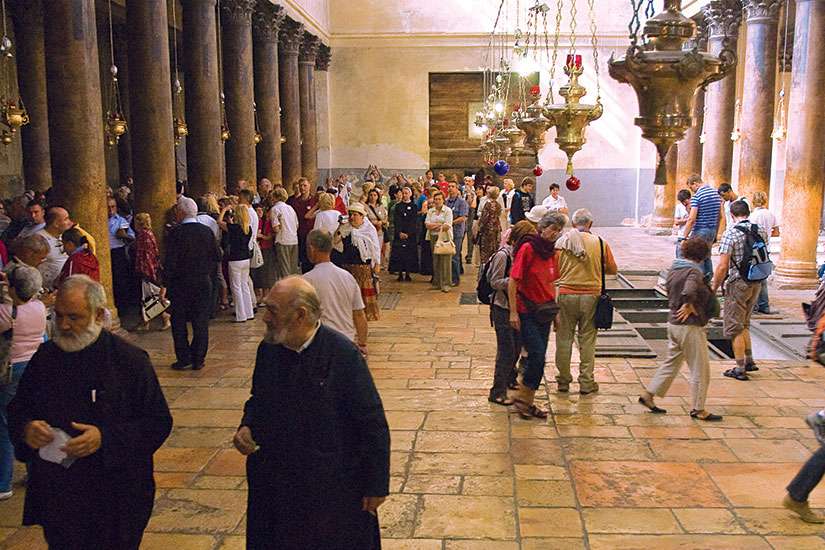When you visit as a pilgrim, you travel back in time to the first Christmas. You look up at the same stars and out at the same shepherds’ fields. You enter the same cave-grotto and touch the same spot where the Christ-child was born incarnate.
The history of this place of the Nativity is fascinating and the hand of Providence can be seen guiding and protecting it every step of the way.
In 135, Christian places of worship in the Holy Land were obliterated under the anti-Christian Emperor Hadrian, and shrines dedicated to Roman gods were erected in their place. A pagan shrine was thus constructed atop the grotto where Christ was born. This seeming tragedy later proved a blessing in that these pagan temples helped Christians to locate and identify the exact locations of the revered sites after the anti- Christian persecutions subsided.
When the delegation of the first Christian Emperor, Constantine, arrived in the Holy Land, it was this pagan shrine which helped to lead his mother, St. Helena, to locate the site indelibly as the place of the birth of Christ. Constantine ordered Hadrian’s temple removed and the cave was found intact below.
At the direction of his saintly mother, Constantine further ordered a magnificent basilica constructed over the site in 325. Known as the Church of the Nativity, it was richly decorated with marble mosaics and frescoes. No expense was spared in its construction. It was so elaborate and permanent that the original octagonal altar and the foundations can be seen to this day. Over the centuries, however, the Church of the Nativity would be looted and sacked on numerous occasions. In 529, it was badly damaged by the Samaritans who were revolting against the Byzantine Empire. Thankfully, it was immediately rebuilt by the Emperor Justinian in 530. The Justinian church is the one still standing today.
The fact that this ancient church still stands is a miracle. In 614 when the Persians destroyed all churches in the locale, it was the only church to evade destruction thanks to a mosaic of the Nativity representing the wise men in ancient Persian costumes. This deterred the marauding Persians from destroying this church and it is now the oldest church in the Holy Land.
Over the years, the Justinian and later the crusader decorations that adorned the walls and columns were destroyed. What remains today are the two rows of red limestone columns standing starkly in the austere church beneath an oak ceiling that was presented by Edward IV of England and Philip Duke of Burgundy in 1482. Remains of the original mosaic floor from Constantine’s church can be seen through trapdoors in the floor.
When you approach the church, you first see the exterior, which appears as a fortress. The front façade, upon inspection, clearly had three original doors, two of which you can see were walled up. Of the third middle door, there remains a low narrow entrance which admits one into the church. The entrance was lowered twice to prevent armed invaders from entering on their horses. Overshadowed by the massive stone walls, this is called the door of humility. When you enter, you have to bow your head while leaning over and stepping up. Only children enter with ease. It is quite the entry into the darkly lit, sixth-century place of worship.
Entering the church, you recognize the distinct rectangular shape, the Roman basilica style. The church has the shape of a cross, 170 feet long and 80 feet wide. Forty-four Corinthian columns in four rows of local stone divide the church into five aisles. On the upper part of the church and transept walls, mosaic fragments can be seen, which are all that is left of the crusader wall decorations. The beautiful Greek Orthodox choir and altar stand above the cave in the area of the sanctuary. Once you have approached the sanctuary on the right, you descend the stairs into the dark and crowded grotto where Christ was born. The grotto is small, rectangular in shape, about 35 feet by 10 feet and lit by 32 perfumed oil lamps. The walls and floors are covered in worn marble. The original ceiling has been replaced by one made of masonry in the fourth century. The walls are covered in asbestos — guaranteed against fire, donated in 1874 by the president of the French Republic.
The grotto cave is divided into two parts: the place of birth and the holy manger. Beneath the altar of the Nativity is the main attraction: a silver star placed on the floor in 1717 which marks the actual birthplace of Christ. It has a Latin inscription which reads: “Here Jesus was born of the Virgin Mary.” You wait in line, enter the room and kneel atop rich oriental rugs. Leaning over the star with your palms on the cold marble amid the smell of rose petals and sweet oil lamps you touch the centre of the star and quickly make your prayer. It is just you and Christ in that moment — your moment.
In the same grotto is also the place where Christ was laid in the manger. Here came the wise men from the East guided by a star to worship Jesus (Mat 2:1-11), and so did the shepherds. Opposite the manger, an altar has been erected and dedicated to the Magi. The original rock of the cave, blackened by the smoke of candles and oil lamps of the centuries, may be seen above the site of the holy manger. As you touch it, you feel you have indeed made the right decision in travelling to the Holy Land. Walking up from the grotto, you hear a voice in your heart, truly “We have found the Messiah” (Jn. 1:41).
(J.P. Sonnen is a tour operator and history guide with Vancouver based Orbis Catholicus Travel.)


